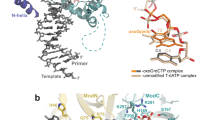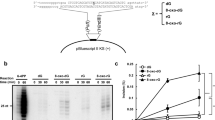Abstract
It has been shown previously that deoxyguanosine residues in DNA are hydroxylated at the C-8 position both in vitro and in vivo to produce 8-hydroxydeoxyguanosine (8-OH-dG) by various agents that produce oxygen radicals such as reducing reagents-O2, metal ions-O2, poryphenol-H2O2-Fe3+, asbestos-H2O2 or ionizing radi-ation1–5. These agents are mostly either mutagenic or carcinogenic; therefore, the formation of 8-OH-dG can also be considered a likely cause of mutation or carcinogenesis by oxygen radicals. It is of interest to know whether the 8-OH-dG residue in DNA is misread during DNA replication. To answer this question, we have examined the effect of the 8-OH-dG residue in DNA on the fidelity of DNA replication using a DNA synthesis system in vitro with Escherichia coli DNA polymerase I (Klenow fragment). The syn-thetic oligodeoxynucleotides, with or without an 8-OH-dG residue in a specified position, were chemically synthesized and used as templates for DNA synthesis under the conditions of the dideoxy chain termination sequencing method. Surprisingly, in addition to misreading of the 8-OH-dG residue itself, pyrimidines next to the 8-OH-dG residue (G has not yet been tested) were also misread.
This is a preview of subscription content, access via your institution
Access options
Subscribe to this journal
Receive 51 print issues and online access
$199.00 per year
only $3.90 per issue
Buy this article
- Purchase on Springer Link
- Instant access to full article PDF
Prices may be subject to local taxes which are calculated during checkout
Similar content being viewed by others
References
1.H. & Nishimura, S. Nucleic Acids Res. 12, 2137–2145 (1984). 2. H. & Nichimura, S. Gann 75, 565–566 (1984). 3. Kasai H. & Nishimura, S. Gann 75, 841–844 (1984). 4. Kasai H., Tanooka, H. & Nishimura, S. Gann 75, 1037–1039 (1984). 5. Kasai H. et al. Carcinogenesis 7, 1849–1851 (1986). 6. Moore, P. D., Bose, K. K., Rabkin, S. D. & Strauss, B. S. Proc. natn. Acad. Sci. U.S.A. 78, 110–114 (1981). 7. Moore, P. D., Rabkin, S. D., Osborn, A. L., King, C. M. & Strauss, B. S. Proc. natn. Acad. Sci. U.S.A. 79, 7166–7170 (1982). 8. Yoshida, S., Koiwai, O., Suzuki, R. & Tada, M. Cancer Res. 44, 1867–1870 (1984). 9. Rouet, P. & Essigmann, J. M. Cancer Res. 45, 6113–6118 (1985). 10. Maxam, A. M. & Gilbert, W. Meth. Enzym. 65, 499–560 (1980). 11. O'Connor, D. & Stohrer, G. Proc. natn. Acad. Sci. U.S.A. 82, 2325–2329 (1985). 12. Ames, B. N. Science 204, 587–593 (1979). 13. Caruthers, M. H. Science 230, 281–285 (1985). 14. Ikehara, M. et al. Proc. natn. Acad. Sci. U.S.A. 81, 5956–5960 (1984). 15. Lin, T.–S., Cheng, J.–C., Ishiguro, K. & Sartorelli, A. C. / med. Chem. 28,1194–1198 (1985). 16. Ito, H., Ike, Y., Ikuta, S. & Itakura, K. Nucleic Acids Res. 10, 1755–1769 (1982). 17. Silberklang, M., Gillum, A. M. & RajBhandary, U. L. Nucleic Acids Res. 4,4091–4108 (1977). 18. Jay, E., Bambara, R., Padmanabhan, R. & Wu, R. Nucleic Acids Res. 1, 331–353 (1974). 19. Sanger, R, Nicklen, S. & Coulson, A. R. Proc. natn. Acad. Sci. U.S.A. 74, 5463–5467 (1977).
Author information
Authors and Affiliations
Rights and permissions
About this article
Cite this article
Kuchino, Y., Mori, F., Kasai, H. et al. Misreading of DNA templates containing 8-hydroxydeoxyguanosine at the modified base and at adjacent residues. Nature 327, 77–79 (1987). https://doi.org/10.1038/327077a0
Received:
Accepted:
Issue Date:
DOI: https://doi.org/10.1038/327077a0
This article is cited by
-
Genome-wide impact of hydrogen peroxide on maintenance DNA methylation in replicating cells
Epigenetics & Chromatin (2021)
-
Watching a double strand break repair polymerase insert a pro-mutagenic oxidized nucleotide
Nature Communications (2021)
-
Acute benzo[a]pyrene exposure induced oxidative stress, neurotoxicity and epigenetic change in blood clam Tegillarca granosa
Scientific Reports (2021)
-
Impact of cadmium on forage kale (Brassica oleracea var. viridis cv “Prover”) after 3-,10- and 56-day exposure to a Cd-spiked field soil
Environmental Science and Pollution Research (2021)
-
Biochemical characterization and mutational studies of the 8-oxoguanine DNA glycosylase from the hyperthermophilic and radioresistant archaeon Thermococcus gammatolerans
Applied Microbiology and Biotechnology (2019)
Comments
By submitting a comment you agree to abide by our Terms and Community Guidelines. If you find something abusive or that does not comply with our terms or guidelines please flag it as inappropriate.



